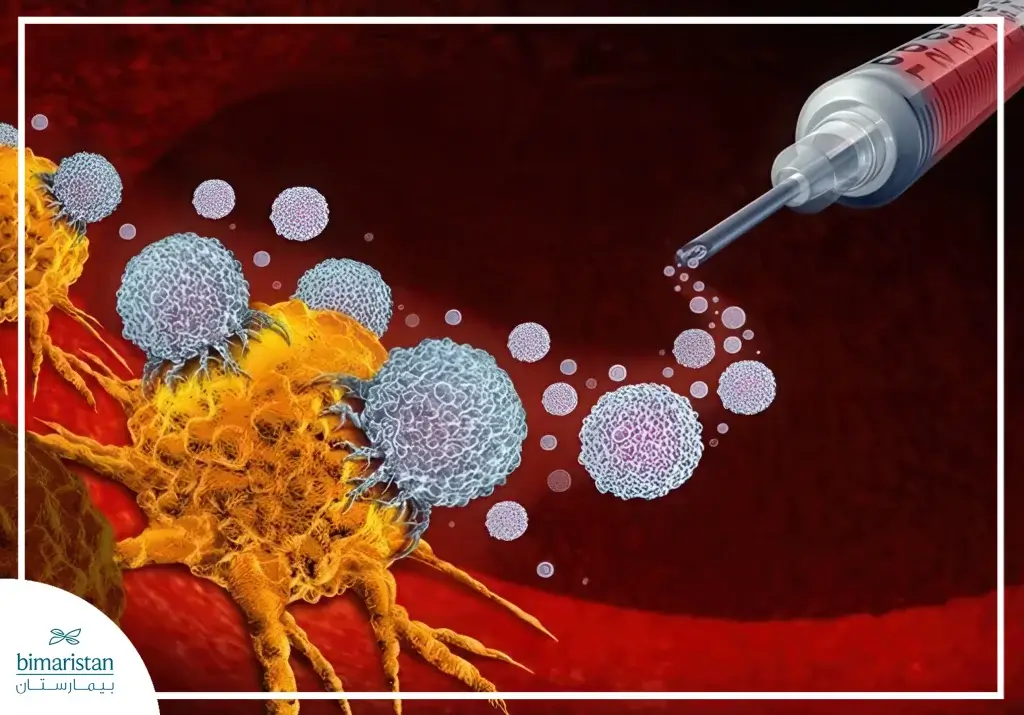Mediastinal tumors have long presented a formidable challenge in oncology due to their delicate anatomical location and varied histological profiles. In light of the limited efficacy of conventional therapies in some instances, immunotherapy for mediastinal tumors has emerged as a promising alternative, reshaping treatment strategies in recent years. How exactly does immunotherapy intervene in tumor control? Which agents have led this therapeutic shift? Could immunotherapy for mediastinal tumors represent the definitive path forward in thoracic oncology? In this article, we present the latest findings and clinical studies in this rapidly advancing field with clarity and scientific integrity.
What are mediastinal tumors?
Mediastinal tumors are abnormal growths located within the mediastinum, the central compartment of the chest situated between the lungs, behind the sternum, and in front of the spine. These tumors may be benign or malignant, originating from various tissues such as the thymus gland, lymph nodes, nerves, or blood vessels.
While many mediastinal tumors remain asymptomatic in early stages, symptoms like persistent cough, shortness of breath, chest discomfort, or difficulty swallowing may develop as the mass enlarges and compresses surrounding structures.
The underlying causes vary by tumor type; some are due to thymic hyperplasia, while others originate from lymphatic or germ cell sources. Treatment decisions rely on the nature of the tumor and its anatomical location, ranging from surgery and radiation to chemotherapy. Recently, immunotherapy for mediastinal tumors has gained traction, offering a targeted and potentially transformative approach, particularly in cases that are less responsive to conventional options.
What is immunotherapy, and how does it work?
Immunotherapy is a breakthrough in cancer treatment that relies on stimulating the body’s immune system to recognize and attack cancer cells. Unlike conventional treatments, such as chemotherapy, which can cause damage to both healthy and cancerous cells, immunotherapy targets only the diseased cells, thereby minimizing unwanted side effects and increasing accuracy.

How does immunotherapy work?
Immunotherapy relies on boosting the natural immune response against the tumor, which is done through multiple mechanisms:
- Stimulate the immune system to recognize cancer as a threat, activating powerful defense cells to attack it
- Directly targeting cancer cells by either preventing their growth or disrupting the escape signals they use to avoid immune detection
- Harnessing the body’s natural defenses through advanced biological tools that redirect the immune system to the cancerous focus
Types of immunotherapy:
- Immune Checkpoint Inhibitors: These drugs work by disrupting proteins that inhibit immune cells, allowing them to recognize and effectively attack cancer cells, including PD-1, PD-L1, and CTLA-4.
- Adoptive T-cell Therapy: T-cells are collected from the patient, modified or activated in the laboratory, and then reintroduced into the body to attack the tumor with enhanced strength. The most prominent type of this therapy is CAR T-cell technology, which has shown remarkable results in certain types of cancer.
- Cancer Vaccines: These vaccines aim to stimulate the immune system to target specific cancer cells in a manner similar to vaccines used against viruses, but with a customized design for each type of tumor.
Advantages of immunotherapy:
- More precise targeting: Focuses on destroying cancer cells without significantly damaging healthy cells
- Long-lasting responses: In some cases, it leads to lasting results or even full recovery
- Less severe side effects: Often less than those caused by chemotherapy or radiation treatments
The role of immunotherapy for mediastinal tumors
In recent years, immunotherapy for mediastinal tumors has emerged as a leading innovation in cancer treatment, particularly when surgical intervention or chemotherapy proves ineffective or unfeasible. This therapeutic approach activates the body’s immune system to accurately identify and destroy cancer cells. Although immunotherapy has shown notable success in various malignancies, its role in mediastinal tumors remains in the exploratory phase, supported by ongoing clinical studies aimed at enhancing its efficacy and defining best-use protocols. Today, immunotherapy for mediastinal tumors includes promising agents such as PD-1 inhibitors and monoclonal antibodies, signaling a paradigm shift in thoracic oncology.
- Thymic epithelial tumors (TETs): Checkpoint inhibitors such as Pembrolizumab have shown promising results, especially in advanced or recurrent cases.
- Primary mediastinal large B-cell lymphoma (PMBCL): Immunotherapy combined with chemotherapy is an effective option, especially in patients who do not respond to the initial treatment.
- Other types of mediastinal tumors: Such as germ cell tumors and mediastinal sarcomas, are still under study and require further research to determine their response to immunotherapy.
Benefits of immunotherapy for mediastinal tumors
By harnessing the immune system’s ability to recognize and attack cancer cells, immunotherapy can induce long-lasting responses, improve survival, and even pave the way to a cure in some patients, including in mediastinal tumors:
- Improved survival rates: Immune checkpoint inhibitors have been shown to improve overall survival (OS) and progression-free survival (PFS) rates not only in common cancers but also in certain mediastinal tumors, allowing patients to potentially live longer with better disease control.
- Long-term responses: In some cases, immunotherapy leads to significant tumor shrinkage or even complete tumor disappearance, resulting in a substantial improvement in the patient’s quality of life and better long-term tumor control.
- The potential for recovery: While this scenario does not apply to all patients, immunotherapy has, in some cases, led to a clinical cure where the tumor completely disappears and shows no signs of returning for prolonged periods.
- Reduce reliance on chemotherapy: Immunotherapy can be used as an alternative or complementary option to chemotherapy, reducing the need for high doses of toxic drugs and alleviating the associated side effects.
- Efficacy in advanced or metastatic cases: Immunotherapy is an effective option for advanced or metastatic mediastinal tumors, particularly when other treatment options are limited or ineffective.
Challenges and side effects of immunotherapy
Immunotherapy offers significant therapeutic benefits; however, activating the immune system can result in various side effects, which can vary in severity from one individual to another. These symptoms typically arise from an excessive immune response, during which the immune system may inadvertently attack healthy tissues alongside cancer cells. Some common side effects include:
- General fatigue: A persistent feeling of fatigue or weakness, even without exertion.
- Skin conditions: Rashes, itching, dry skin, or in some cases, peeling skin and blisters.
- Flu-like symptoms: These include fever, chills, muscle aches, and general malaise.
- Digestive problems: Nausea, diarrhea, vomiting, or abdominal pain.
- Inflammation of the lungs: Causes a dry cough, difficulty breathing, and chest pain.
- Colitis: Leads to severe diarrhea, intestinal cramping, and may be associated with bleeding.
- Immune hepatitis: Appears as extreme fatigue, yellowing of the skin and eyes (jaundice), and pain in the upper abdomen.
- Myocarditis: Rare but serious, it can cause chest pain, shortness of breath, and irregular heartbeat.
- Neurological symptoms: Headaches, dizziness, mental confusion, or, in rare cases, seizures.
- Endocrine disruption: Disorders of thyroid or pituitary function, which may manifest as weight changes, mood swings, or unexplained fatigue.
Challenges associated with immunotherapy:
- Unexpected efficacy: Not all patients respond to immunotherapy, making it difficult to predict who will benefit in advance..
- Heterogeneity of tumor cells: Tumors may contain heterogeneous cells, leading to an incomplete response to treatment.
- Resistance to treatment: In some cases, tumors develop mechanisms to resist immunotherapy over time.
- Lack of accurate biomarkers: Identifying accurate biomarkers (such as PD-L1 or TMB) to predict response is an ongoing scientific challenge.
The future of immunotherapy in mediastinal tumors
The future of immunotherapy for mediastinal tumors appears increasingly promising, driven by advances in biotechnology and evolving treatment protocols. Its clinical efficacy is currently under rigorous evaluation across multiple trials, aiming to define its optimal role in thoracic oncology. Researchers are also exploring combinational strategies, pairing immunotherapy with chemotherapy, radiation, or targeted therapies, to enhance therapeutic response and overcome tumor resistance. Among the innovative approaches showing potential for improved outcomes:
- CAR-T cell therapy
- Tumor-lysing viruses
- Therapeutic cancer vaccines
- Adoptive cellular immunotherapies
With rapid progress in oncology and immunology, immunotherapy for mediastinal tumors has emerged as one of the most promising treatment approaches, particularly in challenging or advanced cases where conventional therapies are less effective. By mobilizing the immune system to selectively target cancer cells, immunotherapy for mediastinal tumors holds the potential to significantly improve both patient survival and overall quality of life.
Sources:
- National Cancer Institute. (2019, September 24). Immunotherapy to treat cancer. National Cancer Institute
- National Library of Medicine. (2025, March 18). Cancer immunotherapy. MedlinePlus.

